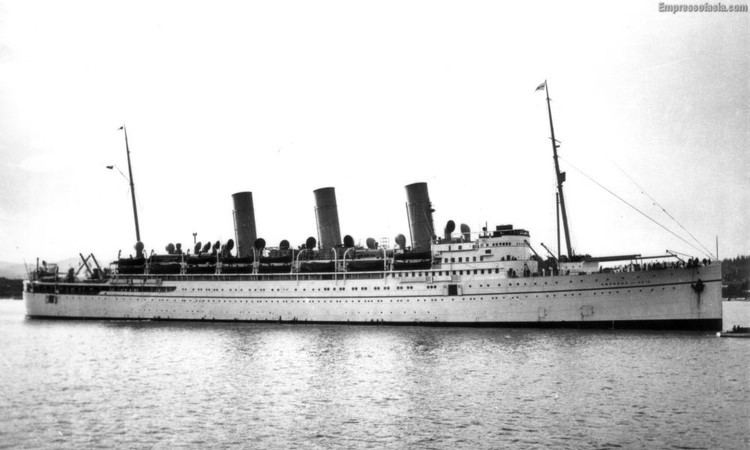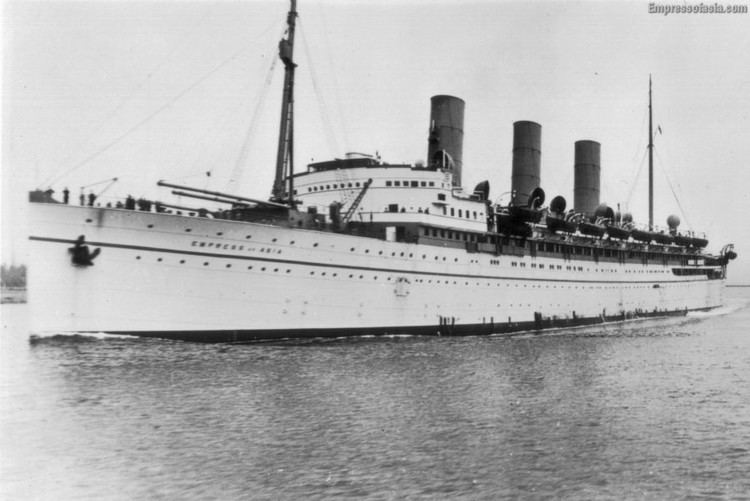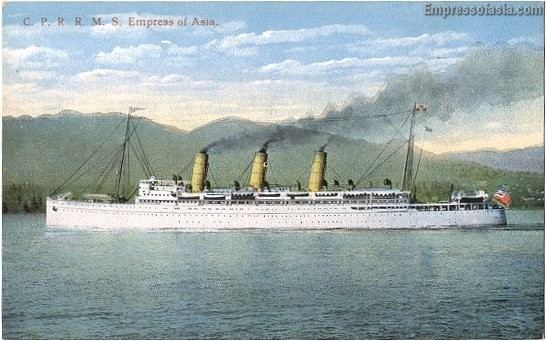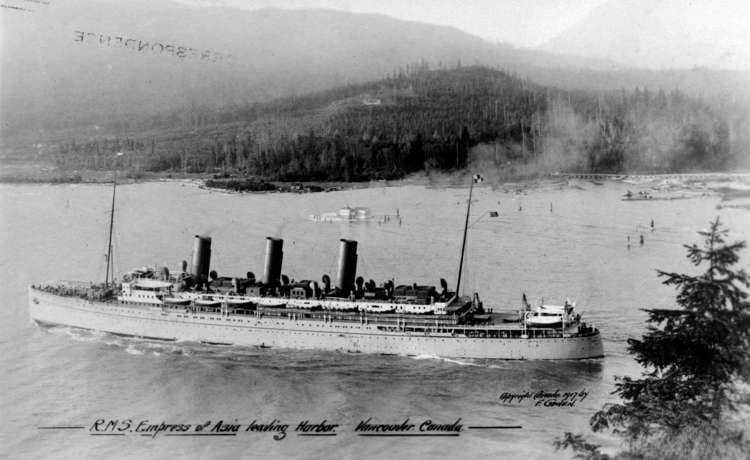Name Empress of Asia Completed June 1913 Launched 23 November 1912 Draft 13 m | Port of registry Canada Length 174 m Beam 21 m | |
 | ||
Owner Canadian Pacific Steamships Fate Sunk by Japanese aircraft off Sultan Shoal on 5 February 1942. Builder Fairfield Shipbuilding and Engineering Company | ||
Rms empress of asia canadian pacific prokofiev cinderella waltz
RMS Empress of Asia was an ocean liner built in 1912–1913 by Fairfield Shipbuilding and Engineering at Govan on the Clyde in Scotland for Canadian Pacific Steamships.
Contents
- Rms empress of asia canadian pacific prokofiev cinderella waltz
- Service history
- World War I
- Inter war period
- World War II
- References

As well as being a passenger liner in peacetime, Empress of Asia served as an armed merchant cruiser and a troopship in wartime. She was sunk during World War II by Japanese aircraft while transiting from Bombay to Singapore.
Service history

The Empress of Asia was built by Fairfield Shipbuilding and Engineering at Govan near Glasgow in Scotland She was launched in 1912 where she was named by Mrs Bosworth the wife of the Vice-President of the Canadian Pacific Railway, she completed her maiden voyage in 1913.

In May 1914, Captain Samuel Robinson pushed the RMS Empress of Asia and her crew in setting a new world's record for both a single day's steaming (473 nautical miles) and for crossing the Pacific (nine days, two hours, and fifteen minutes).
World War I

During the First World War, the Empress of Asia was converted into an auxiliary cruiser at Hong Kong. She was armed with eight 4.7-inch (12 cm) guns and Royal Navy officers assumed command. Among her peacetime crew only those in the Royal Naval Reserve were retained.
She was deployed in Asia, in the Middle East and in the Atlantic with Chinese, British Indian and Portuguese Indian (Goan) crew.
In late 1914, the Empress of Asia was among the cruisers tasked with hunting the German light cruiser SMS Emden in the Indian Ocean east of Ceylon. The Empress of Asia transported wounded German prisoners from the sunken Emden to Columbo.
On 9 September 1918, the Empress of Asia set sail from Hoboken, NJ bound for Liverpool carrying troops from the 86th Infantry Division's 331st Machine Gun Battalion, 311th Engineer Regiment and 311th Engineer Train. She arrived safely on 21 September 1918.
In 1919, the Empress of Asia returned to Vancouver carrying the 72nd Battalion, Seaforth Highlanders of the Canadian Expeditionary Forces (CEF); and the men disembarked from the ship at the CPR pier.
Inter-war period
Amongst the celebrities who sailed in Empress of Asia was Bertrand Russell. The writer traveled from Yokohama to Vancouver in the late summer of 1921.
On 11 January 1926, Empress of Asia rammed the British coastal steamer Tung Shing in the Yangtze at Shanghai, China. Tung Shing sank with the loss of between five and ten lives.
Empress of Asia and Empress of Canada evacuated civilians from Shanghai in 1937 during the Second Sino-Japanese War.
World War II
The Empress of Asia was requisitioned by the British Admiralty in January 1941, and sailed for Liverpool via the Panama Canal to the River Clyde for refitting as a troopship. For armament she received a 6-inch gun, a 3-inch gun HA, 6 20 mm Oerlikons, 8 Hotchkiss, Bofors guns, 4 PAC rockets and depth charges.
Her first task was to take soldiers of the Green Howards to Suez via the Cape of Good Hope to participate in the North Africa Campaign. From there she took Italian prisoners of war to Durban.
In September 1941, the Empress of Asia sailed with the first convoy from North America to England which was escorted by ships of the United States Navy.
The final voyage of the Empress of Asia began in November 1941, when she sailed from Liverpool carrying troops and supplies bound for Africa, Bombay and Singapore.
Empress of Asia was one of five CPR ships that were taking men and materiel to reinforce Singapore in the face of the Japanese advance. The convoy, designated BM.12, had come under air attack in Banka Strait on 4 February 1942 suffering only minor damage. On 5 February, as the convoy entered the approaches to Singapore, serious attacks were pressed home south of Sultan Shoal Lighthouse. Nine Japanese dive bombers focused their attack on the Empress of Asia. The second element of the convoy composed of Empress of Asia, Félix Roussel and City of Canterbury escorted by HMAS Yarra and HMS Danae came into sight of vessels in the harbor with Empress of Asia on fire amidships approaching Sultan Shoal. The ship anchored off the shoal with personnel gathered on bow and stern. Escort vessels HMAS Wollongong, HMS Danae, HMIS Sutlej stood by while Commander Wilfred Harrington manoeuvered the bow of Yarra alongside the liner's stern and took off 1804 survivors. HMAS Bendigo (J187), which had been in the harbor, rescued 78 with Wollongong taking the last two persons, the Master and Chief Engineer, off the burning ship. There were 16 deaths. She sank near the island of Sultan Shoal in the Western Anchorage of Singapore about 8 kilometres (5.0 mi) south of the western tip of Singapore Island. Despite salvage efforts organized by Robert Rankin, all the military equipment and other supplies were lost. Singapore would fall to the Japanese only ten days later (15 February 1942), which makes it hard to speculate about what difference it could have made if the Empress of Asia had not been sunk.
The last convoy of evacuees leaving Singapore included the SS Sing Kheng Seng of the Straits Shipping Company, carrying 45 crewmen from the Empress of Asia along with an unknown number of others.
Leonard H. Johnston was chief mate of the Empress of Asia when she went down. He took charge of 40 other young survivors and led his crew-mates safely to Fremantle, Australia. The journey involved sailing on three inter-island steamers to Sumatra, hiking over 100 miles across the island to catch a ferry to Java, and then a voyage from Batavia to Australia aboard a flat-bottomed river boat with Johnston serving as navigator. He was honored with the OBE for his exploits.
